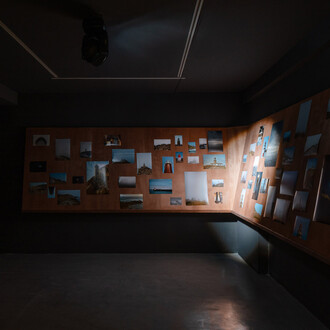Nogueras Blanchard is pleased to present One strike, everything is scattered, including the work of Hans-Peter Feldmann (1941, Düsseldorf), Marine Hugonnier (1969, Paris), Perejaume (1957, Sant Pol de Mar, Barcelona), Valeska Soares (1957, Belo Horizonte, Brazil) and Antoni Tàpies, (1923 - 2012, Barcelona). This exhibition presents different ways in which contemporary artists confront the medium of painting in its most traditional sense, reflecting upon the physical aspects and allegorical connotations while embracing the same tools and processes.
For this occasion, the space has been transformed from the neutrality of the white cube, in which “the apparent simplicity focuses attention without distraction on the straight-forward reality of the object”1 into a domestic environment interspersed with other elements. Arranged by the Madrid based architect and interior designer Jean Porsche, this staging brings us closer to the idea of the Paris Salon whose origin dates back to 1673, the first semi-public art exhibit at the Salon Carré in the Louvre, organized by the Académie royale de peinture et de sculpture. Works that challenged the traditional spirit were rarely displayed on the walls of the Salon, a situation that eventually led to dissent and divisions in the increasingly diverse artistic scene One strike, everything is scattered refers to a simple gesture having far-reaching effects. The exhibition takes its name from a page in the children's book About Two Squares: A Suprematist Tale of Two Squares in Six Constructions 2 (1920) published in the midst of Suprematism and Constructivism by El Lissitzky 3 (1890-1941), in which two intergalactic squares take on the mission of rebuilding the world. About Two Squares was "constructed" using pure geometric forms and typographic elements as a means to disseminate the new order. The book –beyond a political allegory and metaphor of the dialogue between Suprematism's cosmic vision and the new Constructivist typography– was intended as a stimulus for active play by encouraging construction, composition and painting.
In the same way, the works proposed in the exhibition relinquish painting’s classical condition and elaborate new narratives on the pictorial medium and its cosmologies. Feldmann, with surprising humor and subtle intervention, systematically reconstructs pre-existing images – Rembrandt's instantly recognizable face– to reflect on the representation and construction of ideologies. The play of appropriation and subversion continues in Tàpies's work. The tenuous gesture transformed into an insolent one covers the portrait of his grandfather, exhibited here for the first time, with an iconoclastic veil of his personal lexicon of symbols. Soares rescues forgotten images –always portraits of women– that were once part of someone’s affective universe, showing us only a detail of the original painting, selected and cut by the artist, like the ghost of the omitted image. Turning these images inside out, revealing their altered reverse: a monochromatic surface 4 painted with a color selected from the original composition. On the other hand, Hugonnier investigates the temporality of painting, examining the restoration process as something that induces the work of art to live in the present as it did in the past, and by doing so, alters its effects, changing its state and conditions of understanding.
Finally, Perejaume's gesture constitute the total rupture of the square, constructing and re-articulating references to landscape painting, with the same elements that define and limit its boundaries.
















